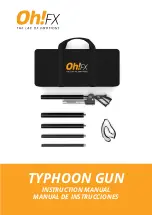
MOTOR / WHEEL POSITION
The gap between the wheels is a
critical adjustment to maximize pitch speed and accuracy. The optimal
distance between wheels depends on the size and compressibility of the
ball being used. Softer, more compressible balls require a smaller gap
than harder balls do. And of course, softballs require a much larger gap
than baseballs. Too small of a gap will slow the wheels noticeably when
pitches are thrown, producing a loud “thunk”. Too large of a gap will not
generate enough squeezing force on the ball, and pitches will be too
slow, without enough spin. As a general rule, when the gap is correct,
you should be able to feed a ball through an unpowered machine by
rotating the wheels by hand with a moderate effort.
Each motor & wheel assembly has two profiled blocks that interlock with
profiled pockets in the frame. There are 11 possible locations. By
counting the number of empty notches on either side of the blocks, you
can quickly and precisely locate each of the wheels. See Figures 6-9 for
the typical positioning for real baseballs and softballs. For baseball, the
blocks are in the center position, with 5 empty notches on each side of
the block. For softball, the blocks are located at the outermost position,
with all 10 empty notches on the inside. Each wheel and motor assembly
should be moved one step inward from these locations when using soft
dimpled balls, creating a tighter grip on the compressible ball.
The wheels are moved by loosening or removing the clamping knob that
holds each motor to the frame. Be sure to support the motor / wheel
assembly when removing the knobs – do not let the motor fall or hang by
its cord. Reposition the motor & wheel assembly as desired, then re-
tighten the clamping knob.
The positions shown in Figures 6-9 are just starting points and may
require adjustment for optimal performance. Each motor does not need
to be set at the same distance from center, but they should not be more
than one setting apart.
Feel free to experiment and deviate from these suggestions to determine
the optimal wheel gap for your situation. For example, cold weather will
cause both the balls and wheels to harden, requiring a larger wheel gap
than when the same machine is used in hot weather. Also, once the
wheels begin to wear, they will need to be moved closer together to
compensate.
OPERATION
SPEED CONTROLS
The wheel speeds are individually controlled
by rotary knobs. Both the knobs and the motors are labeled '1' and '2' to






























